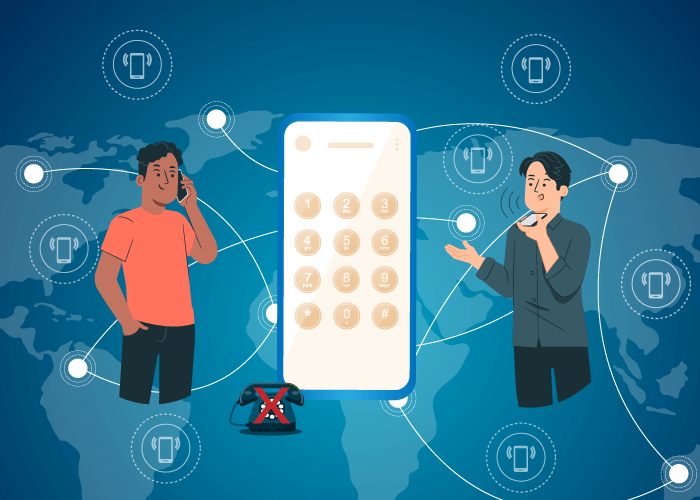Globally, there has been a shift towards digital and internet-based communication services. Many countries are investing in high-speed internet infrastructure, and telecom companies are moving away from traditional copper wire networks.
While POTS has been reliable and served its purpose for many years, the shift towards more advanced and integrated communication technologies is driven by the desire for enhanced features, efficiency, and adaptability to the demands of modern communication.
Let’s examine why POTS lines are being phased out and what POTS replacement options are available for businesses.
Using POTS for Business Communication
Plain old telephone service (POTS) is a traditional telephone system that utilizes copper wires to transmit analog signals for voice communication. It has been the primary telephone service before VoIP and other digital communication techs since the 1880s. This solution is also called the public switched telephone network (PSTN). There are several local and national carriers operating these copper-based networks.
Businesses widely used POTS as it was considered reliable—particularly during power outages, due to its independence from electricity. Setting up POTS is relatively straightforward and viewed as a beneficial feature. One has to connect to the traditional telephone to the existing phone lines, and you’re ready to make and receive calls.
However, POTS has many limitations and drawbacks, such as higher costs, more maintenance, fewer features, etc. In comparison, more advanced communication technologies like VoIP offer better quality service for lower costs.
Why Replace POTS?
POTS replacement services aim to improve efficiency, support new services, and enhance connectivity in the evolving digital landscape. Legacy phone systems are primarily designed for voice calls, lacking advanced features that have become integral to contemporary business operations.
Integrating communication tools with other business applications—like VoIP CRM integrations—and workflows streamlines processes, reduces response times, and enhances productivity.
Also, digital systems outperform POTS in call quality with advanced technologies like digital signal processing, error correction, adaptive voice codecs, and echo cancellation, enhancing voice clarity and minimizing background noise.
Lastly, the upkeep of copper wire infrastructure for POTS can be expensive. Meanwhile, digital and internet-based communication systems often utilize existing broadband infrastructure, proving more cost-effective.
Are POTS Lines Being Phased Out?
Modern phone systems render PSTN obsolete due to its incompatibility with current communication needs and trends.
In 2019, the Federal Communications Commission implemented regulatory changes, such as Order 19-72A1, accelerating the transition from traditional POTS. This initiative supports incumbent local exchange carriers in upgrading to modern telecom infrastructure.
Similarly, the UK is phasing out PSTN by 2025 as part of its digital infrastructure transformation driven by technological advancements. Australia also sees a consistent decline in landline telephone usage. All this indicates better solutions and alternatives are available.
Exploring POTS Alternatives
As POTS becomes obsolete, evaluating available POTS replacement services is crucial. Many businesses are switching to cloud telephony solutions with session initiation protocol (SIP) and voice over internet protocol (VoIP) for business communications. Unlike PSTN, SIP and VoIP leverage digital technology and the internet to transmit voice signals, providing cost savings, advanced features, and enhanced flexibility.
What is the difference between POTS and VoIP?
| POTS | VoIP | |
| Geographical Limits | 1. Numbers tied to locations. 2. Relocation may need number changes. |
1. Get local phone numbers for different countries. 2. Keep the same numbers despite office moves. |
| Infrastructure | 1. Physical phone lines needed. 2. Each number needs separate lines. |
1. Transmits calls via the Internet. 2. Supports multiple phone lines on one account. |
| Technology | 1. Uses analog for voice. 2. Transmits analog signals via copper wires. |
1. Converts voice into digital data for internet transmission. 2. Sends data packets via the internet. |
| Features | 1. Limited features and services. 2. Typically handles voice calling. |
1. Extensive features: advanced routing, voicemail translation, call forwarding, and more. 2. PBX, CRM, and help desk integrations. |
| Cost-effectiveness | 1. Higher costs for international calls. 2. High maintenance cost. |
1. Internet-based calls mean lower long-distance costs. 2. Free calling minutes and competitive rates for local and international calls. |
Related: How Does VoIP Connect to PSTN?
How Can UWT Help?
As modern businesses embrace remote work models, the relevance of POTS dwindles. With unparalleled mobility, flexibility, and scalability, POTS alternatives like VoIP take center stage.
United World Telecom is one of the pioneering VoIP service providers, and we bring vast expertise in modern business communication solutions.
We can help you make the switch to VoIP seamlessly.
Consult with our expert today to explore POTS replacement solutions.


